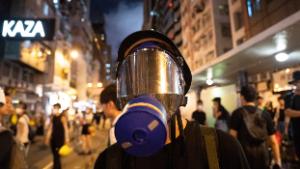Why protests are becoming increasingly faceless
On a humid Sunday night in Hong Kong's financial district, hundreds of young people ready themselves for the latest protest.
Some wear flimsy medical masks and swimming goggles, others heavy-duty respirators and protective glasses. All are covering their faces to protect themselves not only from police tear gas -- but also to obscure their identities.
Hong Kong's pro-democracy activists are concerned about being identified by authorities and prosecuted. Since mass demonstrations kicked off in June, roughly 700 people have been arrested, many for unlawful assembly.
This weekend, demonstrators attempted to tear down or dismantle some of the city's 50 newly-installed so-called "smart lamp posts" -- which have cameras and sensors -- in a protest against perceived government surveillance. The Hong Kong government said the lamp posts, which are intended to track data such as air quality and traffic flow, are not equipped with facial recognition software and "would not infringe upon personal privacy."
But Hong Kong's protesters aren't the only ones worried about protecting their identities.
Activists, designers and artists around the world are inventing creative ways to avoid detection.
As state surveillance becomes more advanced -- and widely used -- wearable technology has been proposed as a way to thwart monitoring systems.
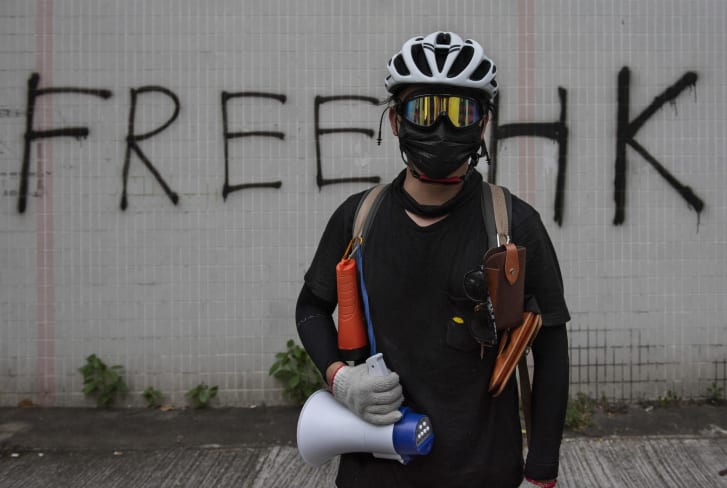
A protester wearing a mask during anti-government protests, which began in response to a proposed extradition law, in Tai Po, Hong Kong, on August 10, 2019. Credit: Miguel Candela/Anadolu Agency via Getty Images
Fighting technology with technology
After witnessing police brutality at protests in his native Brazil in 2013, United States-based designer Pedro Oliveira began researching how authorities around the world deploy technology against demonstrators.
In some countries, there were internet black outs. In others, widespread censorship.
Hoping to raise awareness about the tactics authorities were using against protesters, Oliveira and fellow designer Xuedi Chen created a slick-looking protest kit as part of their art and design project, Backslash.
It includes a "smart" bandana that serves to simultaneously conceal the wearer's identity, while communicating messages between protesters through a computer-generated pattern that can only be read by a custom app.

A woman wears Backslash's smart bandana. According to the concept's designers, different messages can be unlocked depending on which way the bandana is folded. Credit: Backslash.cc
The kit also features a wearable device that alerts fellow demonstrators to the presence of police, and a stencil that creates graffiti "tags" -- readable only by an app -- to inform protesters when an area is under surveillance.
But the kits are not for sale. Instead, Oliveira and Chen hoped to start a dialogue about what they see as an increasing power imbalance between authorities and demonstrators.
"We didn't feel that these should be offered to protesters as a solution. We just thought it was important to research and have a conversation about the hyper-militarization of police and all this technology being used against protesters," Oliveira said in a phone interview.
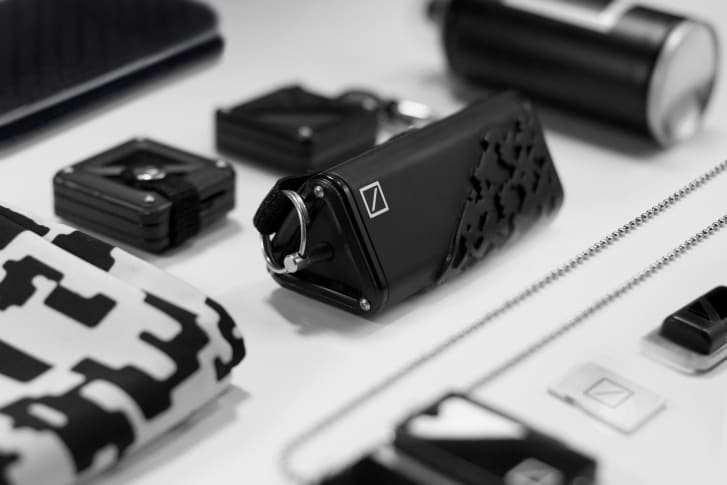
Backlash's survival kit for future protesters includes a router for localized communication during an internet blackout. Credit: Backslash.cc
Advancements in facial recognition technology is of particular concern to demonstrators and privacy campaigners.
The technology, much of which is still in development, works by capturing images of people's faces and matching biometric information -- such as the distance between facial features -- with existing photo ID databases.
In his project CV Dazzle, artist Adam Harvey proposes a number of inventive ways to evade surveillance technology, including face jewels and elaborate hairstyles. On his website, he claims that applying tonal gradients of make-up can create fake contours that obscure people's features -- a kind of "anti-face," as he puts it -- making it harder for facial recognition systems to collect the data needed to identify individuals.
He also recommends make-up be applied asymmetrically, in order to throw off facial-recognition algorithms.
Alternatively, London-based Zach Blas has invented "collective masks" using biometric data from multiple faces in his project "Facial Weaponization Suite." The artist's conceptual masks are a statement on the "inequalities these (biometric facial recognition) technologies propagate," according to his website.
One of the masks addresses facial recognition software's built-in prejudices towards skin color, a criticism that activists have raised before. Critics say that if software is trained using a disproportionate number of male and white faces, there could be an increased chance of women and people of color being misidentified.
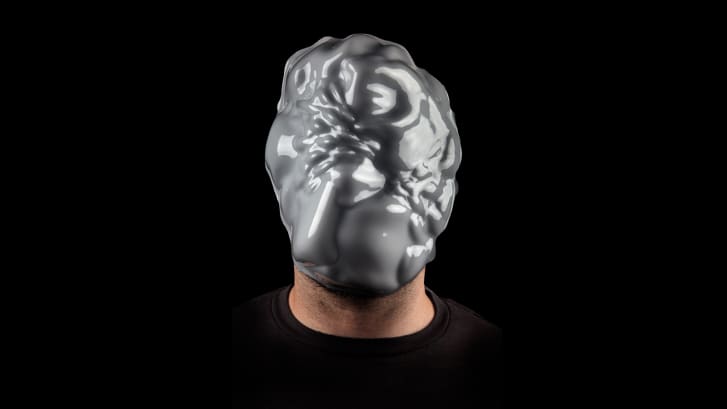
Zach Blas' project "Facial Weaponization Suite" comprises of three different types of masks that he claims cannot be detected as human faces by facial recognition software. Credit: Zach Blas

Participants in a public art performance by Zach Blas in Mexico City. Credit: Orestes Montero Cruz
The resulting disguises look like amorphous, colorful blobs that Blas claimscan fool facial recognition technology -- to the extent that wearers aren't even identified as human.
But these unusual tactics can create problems of their own. As artist Leo Selvaggio points out: "Walking out with this make-up on your face ... actually makes you conspicuous."
Selvaggio believes that people have also been "weaponized" into being part of surveillance, meaning that someone would likely report anything out of the ordinary -- like unusual make-up or a blob-like mask -- to the authorities.
"(Anti-surveillance projects) don't really take into account the human aspect of surveillance," he added in a phone interview.
The artist has proposed another solution: prosthetic masks of his own face. Like Blas' "collective" masks, they hide the wearer's true identity. But unlike Blas' disguises, they would be analyzed as a human face by surveillance systems, fooling authorities into thinking that one person is in multiple places at the same time.

Selvaggio has designed a 3D-printed prosthetic of his face. Credit: Leo Selvaggio
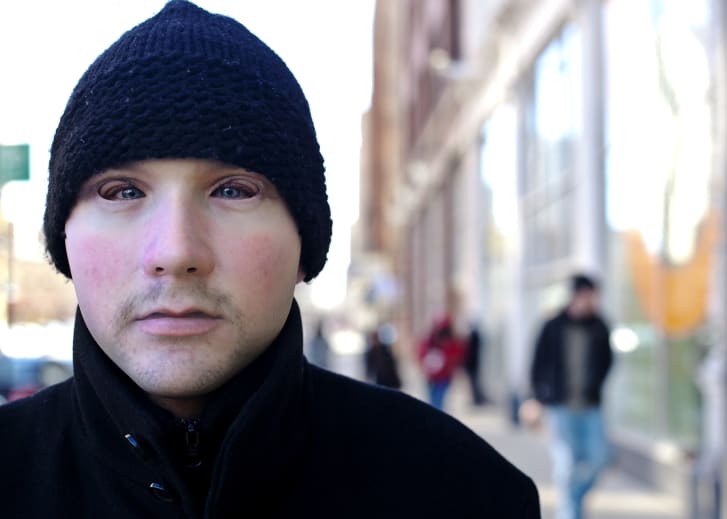
A prosthetic mask created by artist Leo Selvaggio. Selvaggio also created a paper mask as an alternative for groups of activists and protesters. Credit: Leo Selvaggio
Simple solutions in Hong Kong
On the streets of Hong Kong, protesters have opted for readily available solutions.
"People tend to experiment a lot in protest movements," said Gavin Grindon, who curated a 2014 exhibition at the Victoria and Albert Museum in London on objects used in protests.
"It's often the simple solution -- the quick solution -- that's the elegant and effective one," said Grindon.
When it comes to avoiding detection, many opt for a medical or gas mask paired with goggles to obscure their identities.
"We need to hide ourselves so if we get caught on camera, we're safe," said a 22-year-old volunteer first aider, who spoke on condition of anonymity, for security reasons.
She is concerned that if police spot her at the scene, they could pin a crime on her that she didn't commit, or later identify her online, which could put her friends and family at risk.
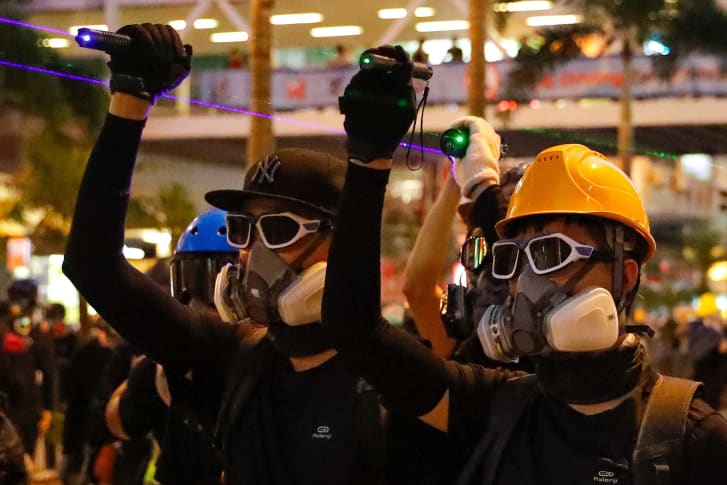
Protesters point laser beams at policemen during a protest in Hong Kong, on August 11, 2019. Credit: Vincent Thian/AP
Young Hong Kong protesters also employ other tactics to cover their digital tracks, such as organizing themselves on encrypted app Telegram, using newSIM cards and single-journey subway tickets, rather than travel cards registered to their names, and adopting code names while talking to one another at demonstrations.
Umbrellas are also widely used to block security cameras, ward off tear gas and provide cover for those painting slogans on walls or unscrewing metal railings from the sidewalk. In recent weeks, protesters have strategically used laser pointers to blind security cameras and distract the police.
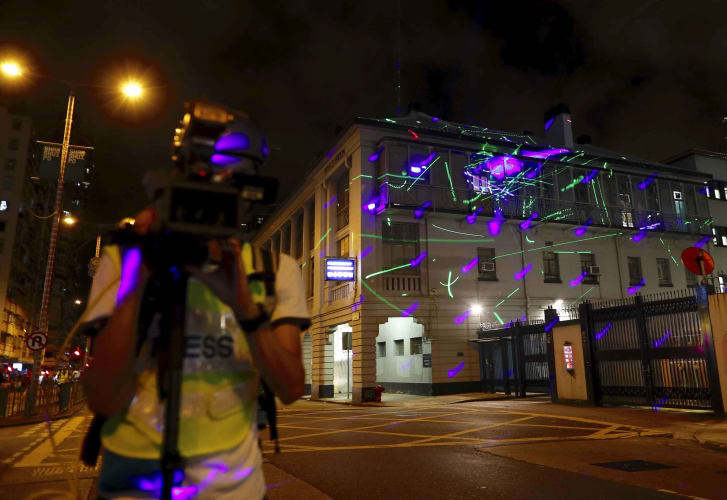
Laser beams shone by protesters light up the Sham Shui Po police station in Hong Kong on August 14, 2019. Credit: Vincent Yu/AP
The 22-year-old volunteer first aider said that these ideas form organically from online discussions.
Protesters offer each other advice, such as wearing identical outfits and taping over brands on their shoes, to blend in with one another. She's also seen some put reflective tape on their goggles, taking a cue from the silver strips that Hong Kong riot police sometimes place on their protective visors.
A police spokesperson would not disclose why they did so, for operational reasons. But the material helps prevent observers from identifying the wearer, as their eyes are hidden from view. A post on online forum LIHKG, the city's answer to Reddit, instructs protesters where to affix it to hide their identity.
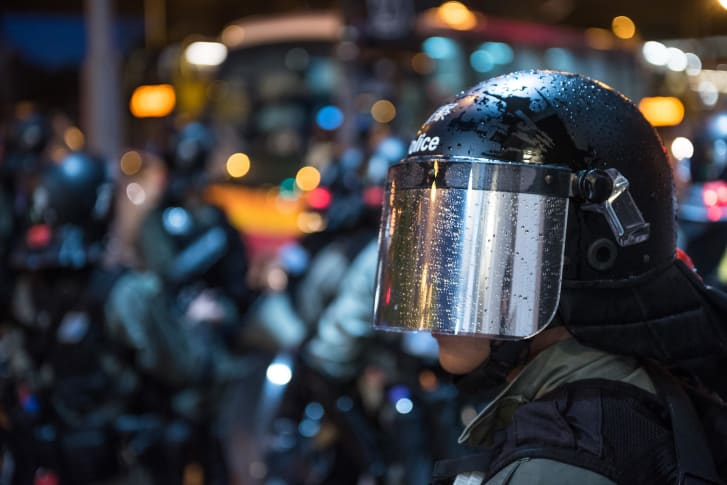
A policeman wears metallic gray material in his helmet as he stands on guard in the rain during a peaceful demonstration in Hong Kong. Credit: Aidan Marzo/SOPA Images/LightRocket via Getty Images
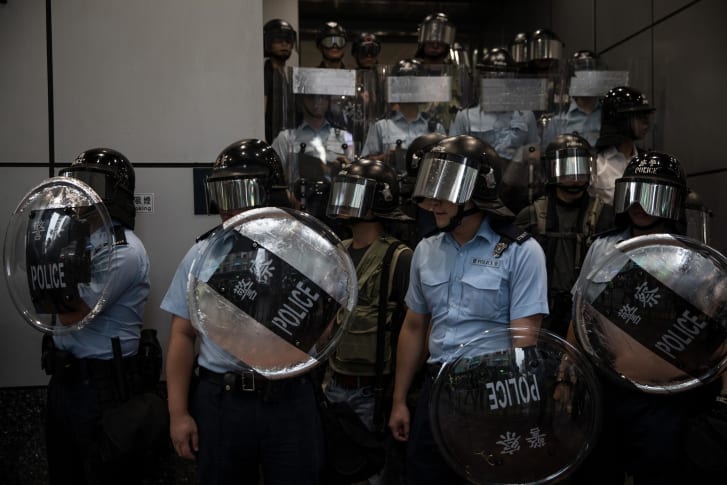
Police stand guard outside Mong Kok police station as pro-democracy protesters gather on August 17, 2019 in Hong Kong.Credit: Chris McGrath/Getty Images
The use of reflective materials to evade surveillance isn't just being explored in Hong Kong. In 2016, American artist Scott Urban set up a Kickstarter page to crowdfund his anti-surveillance sunglasses, Reflectacles.
The eyewear is made from a material that reflects infrared light, meaning the frames appear as flashes of white light in surveillance footage. Because of the glare, a person could appear anonymous in images and photos, his website claims.
Urban said his website has experienced a spike in hits from Hong Kong, as a result of the recent protests.
"I'm not trying to hawk a product," Urban said in a phone interview. "I'm just trying to tell people that when your face becomes your identity, there's no going back. You're going to be tracked constantly in any public space."
How a person wearing Reflectacles looks on camera. Credit: Reflectacles.
Wider concerns
So can the ideas proposed by artists and designers keep up with the ever-improving technology? And can protesters stay ahead of the developments?
Garfield Benjamin, who researches privacy and digital culture at Britain's Solent University, said while concepts might work when they are proposed, they can quickly be rendered obsolete because technology is developing so rapidly.
"It's a bit of an arms race," Benjamin said.
That's because the technology powering facial recognition software is becoming ever more complex.
Some systems now can use machine learning to mimic the way humans recognize each other, according to Lujo Bauer, a professor of electrical and computer engineering and computer science at Carnegie Mellon University.
Other software uses infrared light to create 3D models of a person's face -- the kind of technology used on an iPhone X. These examples are more advanced than simply measuring the distances between facial features.
For now, authorities around the world are mostly using 2D facial recognition technology, which isn't able to recognize depth, said Anil Jain, a computer science professor at Michigan State University. He added that governments may already have access to huge databases of citizens' photos -- such as driver's license pictures or mugshots -- which they can compare with facial recognition data in order to identify individuals.
In mainland China -- which operates under a separate legal system from Hong Kong -- facial recognition technology, according to Human Rights Watch, is already being used with chilling effects.
Beijing has created a mass surveillance system to closely monitor the movement of Uyghurs and other minorities in the far western region of Xinjiang.
In the United States and the United Kingdom, authorities in some cities have started to use facial recognition to catch suspects, but have faced push back from critics who say the technology can be inaccurate, biased and in violation of citizens' privacy rights. San Francisco and Oakland, California, and Somerville, Massachusetts have already prohibited the use of facial recognition on citizens.
"We've gotten to the point (in the US), where these technologies are rolled out around the country with no transparency, no guidelines, regulations, and very little public understanding of actually how the technologies work," said city councilor Ben Ewen-Campen, who sponsored Somerville's measure to outlaw facial-recognition technology.
Play Video
Is facial recognition technology too powerful?
Mass surveillance using facial recognition software relies on infrastructure; and without a web of cameras capturing images of citizens the technology cannot be implemented.
Worldwide, such video surveillance is "ramping up," according to new research by Comparitech.
A report released by the consumer technology website found that eight of the 10 most surveilled cities in the world are in China. London and Atlanta also made the top 10 cities based on the number of CCTV cameras per 1,000 people and Singapore, Sydney and Delhi made the top 20.
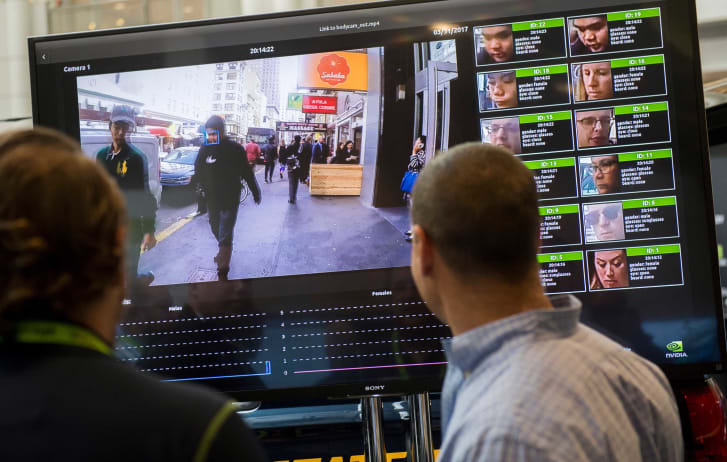
A display shows a facial recognition system for law enforcement during the NVIDIA GPU Technology Conference in Washington, DC, on November 1, 2017. Credit: SAUL LOEB/AFP/Getty Images
In Hong Kong, surveillance measures are worrying protesters. On Saturday, demonstrators clashed with riot police after attempting to forcefully pull down some of the city's smart lamp posts. Despite authorities saying that the lamp posts did not carry facial recognition software, "irrational protesters disregarded the facts and blatantly damaged the smart lamp posts," a Hong Kong government spokesperson said.
Other protesters are concerned about being spotted by the city's CCTV cameras, although the Hong Kong government says the city's CCTV cameras aren't equipped with automatic facial recognition (AFR) technology.
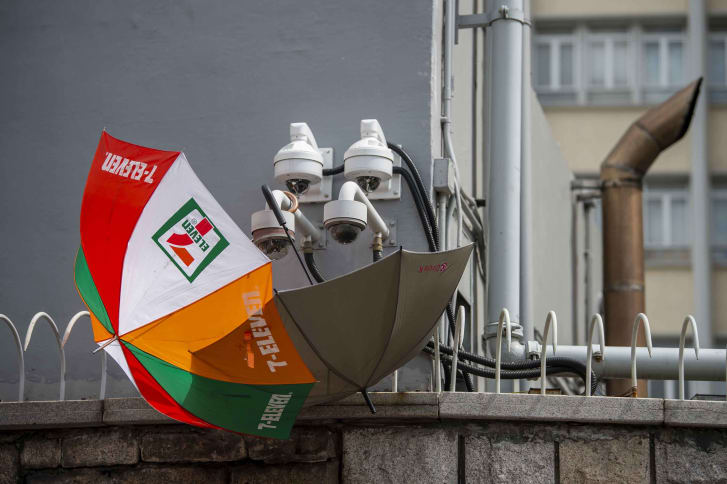
Umbrellas block CCTV cameras during a protest in Hong Kong on June 21, 2019. Credit: Vernon Yuen/NurPhoto via Getty Images
But Hong Kong's protesters aren't just concerned about the short-term issue of being arrested by police.
Many are worried about the future, when the "one country, two systems" arrangement that allows the city certain freedoms and autonomy expires in 2047.
As a 20-year-old student protester -- who only gave his surname, Lau -- took a break in the shade during a protest on a blazingly hot day, he kept his face mask on, even though no police were around.
"We are not prepared to be picked up by the government yet," he said.
News Courtesy: www.cnn.com

